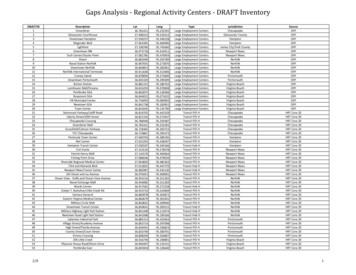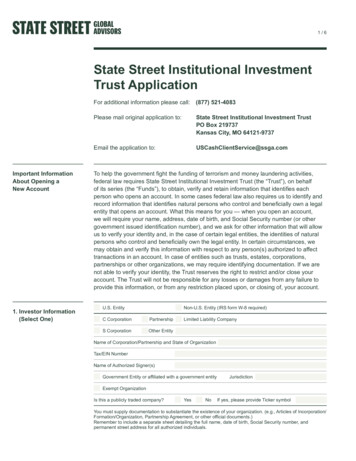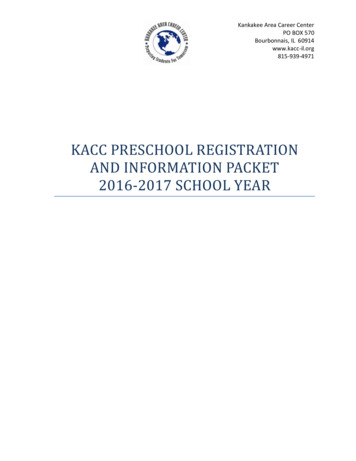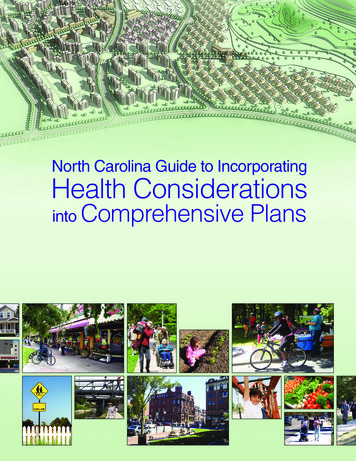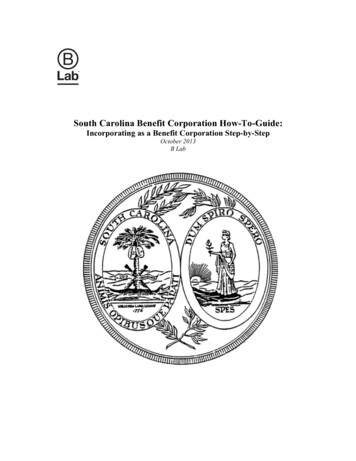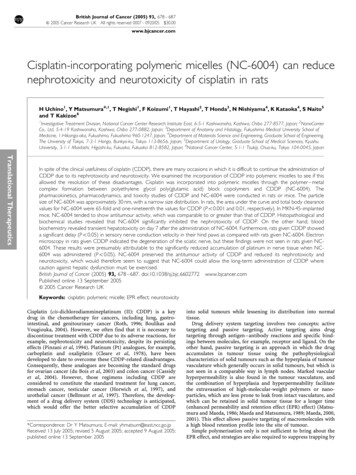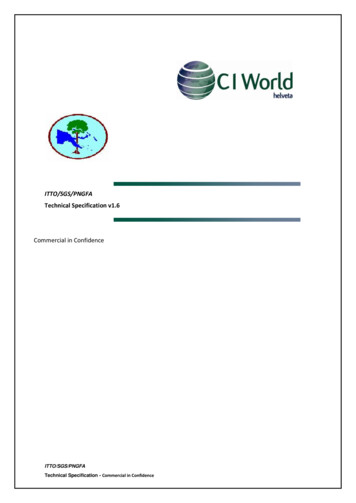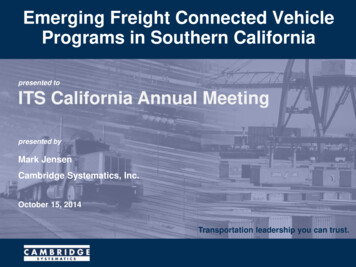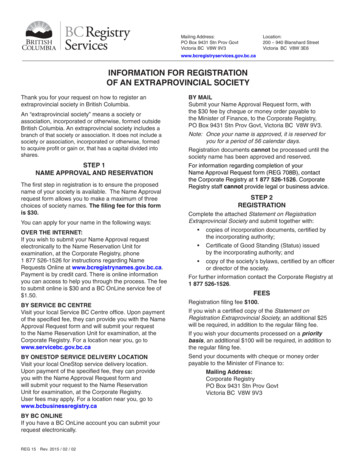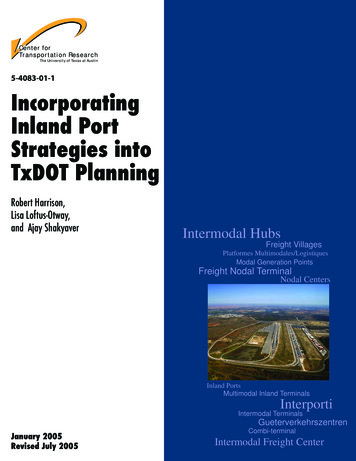
Transcription
Center forTransportation ResearchThe University of Texas at Austin5-4083-01-1IncorporatingInland PortStrategies intoTxDOT PlanningRobert Harrison,Lisa Loftus-Otway,and Ajay ShakyaverIntermodal HubsFreight VillagesPlatformes Multimodales/LogistiquesModal Generation PointsFreight Nodal TerminalNodal CentersInland PortsMultimodal Inland TerminalsInterportiIntermodal TerminalsGueterverkehrszentrenJanuary 2005Revised July 2005Combi-terminalIntermodal Freight Center
5-4083-01-1INCORPORATING INLAND PORT STRATEGIES INTO TXDOT PLANNING:AN IMPLEMENTATION MANUALAuthors:Robert Harrison, CTRLisa Loftus-Otway, CTRAjay Shakyaver, P.E., Texas Department of Transportation, OdessaDistrictProject 5-4083-01: Demonstrating the Inland Port Evaluation GuideJANUARY 2005; REVISED JULY 2005Performing Organization:Center for Transportation ResearchThe University of Texas at Austin3208 Red River, Suite 200Austin, Texas 78705-2650Sponsoring Organization:Texas Department of TransportationResearch and Technology Implementation OfficeP.O. Box 5080Austin, Texas 78763-5080Project conducted in cooperation with Federal Highway Administration and the Texas Department of Transportation.Abstract:In the year 2000 the Texas Department of Transportation (TxDOT) commissioned a research project (0-4083)on the growth of inland ports along transportation corridors in Texas and the United States. This project wasstaffed by a multi-institutional team comprising Jolanda Prozzi (CTR-UT), John McCray (UTSA), andRussell Henk (TTI), and was supervised by Robert Harrison (CTR-UT). Judy Friesenhahn, P.E. (San Antonio)was the Project Director and the Project Coordinator was Luis Ramirez, P.E. (District Engineer at Laredo).Upon completion, the research was selected as a 2002 TxDOT’s Top Research Innovations and FindingsAward winner. As part of the study, CTR, TTI and UTSA researchers developed an “Inland PortTransportation Evaluation Guide.” The guide provides TxDOT planners with a planning and evaluation toolthat can be used when local officials and developers approach TxDOT districts for assistance in the possibledevelopment of an inland port. The guide can also be given to potential developers and local officials so thatthey better understand TxDOT’s procedures and data requirements. To increase the guide’s usage andeffectiveness, a follow-up implementation project was approved for FY04 and undertaken by CTR. The scopeof the implementation project included training of district and metropolitan planning organization (MPO)personnel on (1) the functions of inland ports and (2) use of the guide as an evaluation tool. A secondcomponent of the implementation project was an assessment of the guide’s effectiveness by using the WestTexas Odessa District as an actual case study. The implementation project began in September 2003, and wascompleted in August 2004.Keywords:Inland port strategies,transportationcorridors, porttransportationevaluation guide,MPO, Texas.No. ofPages:42
Table of ContentsIntroduction. 1Overview. 1Acknowledgments. 2Background . 21. District Planning and Inland Ports . 52. Guidance for Reading the Flowchart(s) for Proposed Inland Port/Large BoxDevelopment Process and Proposed Inland Port/Large Box Development,as Incorporated into TxDOT Development Process . 72.1. Inland Ports and TxDOT Planning: General Comments . 153. Interviews. 173.1. Instructions for TxDOT on Scoring the Preparation Phase: BackgroundData on Proposed Facility. 183.1.1. Inland Port Market Analysis . 193.1.2. Inland Port Location, Modes and Planning. 213.1.3. TxDOT—Site-Specific Impact . 223.1.4. Milestones . 233.2. Instructions to TxDOT for Scoring the Establishment Phase: Operationsand TxDOT Planning. 243.2.1. Inland Port—Operations . 253.2.2. Inland Port—Operations and Modes . 263.2.3. TxDOT—Site-Specific Impact . 293.2.4. Milestones . 303.3. Guidance for Interpreting the Evaluation Scores. 314. Conclusions and Recommendations . 33iii
List of FiguresFigure 1. Development Life Cycle of Inland Ports. 3Figure 2. Interest in Inland Ports Continues to Grow . 5Figure 3. Proposed Inland Port/Large Box Development Process . 6Figure 4. Proposed Inland Port/Large Box Development, as Incorporatedinto TxDOT Project Development Process. . 11Figure 5. Evaluator’s Questionnaire for Preparation Phase: Background Dataon Proposed Facility. 18Figure 6. Evaluator’s Questionnaire for Establishment Phase: Operationsand TxDOT Planning . 24v
Toolbox Contents (CD ROM)5-4083-01 P11. Implementation Manual: Incorporating Inland Port Strategies into TxDOT Planning.2. Appendix A – Instructions to the inland port sponsor regarding scoring.3. Appendix B – Sponsor questionnaire to be distributed at initial meeting with districtplanning staff. (Directions to be given to inland port sponsor with questionnaire).4. Appendix C – Sponsor questionnaire document.5. Appendix D – Evaluation team questionnaire document.6. Appendix E – Blank evaluation matrix for head of scoring panel. (Excel spreadsheet)7. Appendix F – Evaluation matrix. (Excel spreadsheet)5-4083-01 P2 PowerPoint PresentationsInland Ports: Planning for Success; J. Prozzi; January 2003Inland Ports: Partnering with TxDOT; R. Harrison; June 2004Notes to Power Point PresentationsInland Ports: Demonstrating the Inland Ports Evaluation Guide; November 2005Reports0-4083-1 - The Identification and Classification of Inland Ports0-4083-2 - Inland Ports Planning Successful Developments0-4083-P4 - Guidebook: Incorporating the Impact of Inland Ports in State TransportationPlans0-4083-S – Project Summary ReportMiscellaneous:Texas Administrative Code: 43 TAC § 15.55 (c).vii
viii
IntroductionOverviewIn the year 2000, the Texas Department of Transportation (TxDOT) commissioned aresearch project (0-4083 Impacts of Inland Ports on Trade Flows and Transportation in Texas)that examined the growth of inland ports along transportation corridors in Texas and the UnitedStates. The multi-institutional research team included: Jolanda Prozzi, Center for Transportation Research–The University of Texas atAustin (CTR-UT)John McCray, University of Texas at San Antonio (UTSA)Russell Henk, Texas Transportation Institute (TTI).The team was led by Robert Harrison (CTR-UT), who served as the Research Supervisor.Judy Friesenhahn, P.E. (San Antonio District), represented TxDOT as the Project Director.Additionally, Luis Ramirez, P.E. (Laredo District Engineer), provided a statewide perspective asthe Program Coordinator.In addition to documenting the growth of trade and inland ports, as well as their potentialimpact to the transportation network in Texas, the researchers produced the Inland PortTransportation Evaluation Guide to be used when inland ports or “large box” privatedevelopment is being proposed. The Inland Port Transportation Evaluation Guide, hereinreferred to as the “Guide” provides TxDOT planners with: An understanding of how inland ports impact the transportation system; andTools to best accommodate inland ports into state transportation planning.Specifically, the Guide is a planning and evaluation tool that can be used when localofficials and developers approach TxDOT districts for assistance in the possible development ofan inland port (or “large box” development). The Guide can also be given to potentialdevelopers and local officials so that they better understand TxDOT’s procedures and datarequirements.To increase the Guide’s effectiveness, a follow-on implementation project (5-4083Demonstrating the Inland Port Evaluation Guide), sponsored by TxDOT, was undertaken byCTR-UT in FY 04. The implementation project began in September 2003 and was complete inAugust 2004. The scope of the implementation project included training of district andmetropolitan planning organization personnel on: The functions of inland ports; andProcedures on how to use the Guide as an evaluation tool.A second component of the implementation project was an assessment of the Guide’seffectiveness by using the Odessa District as an actual case study.Based on experience and lessons learned taken from the case study in the OdessaDistrict, this document was produced. Its purpose is to augment the Guide by supplyingadditional and more detailed information for district planners and engineers to use when working1
with developers and local government officials who are proposing inland port or “large box”development. In addition to this report and the Guide, the Inland Port CD-ROM Toolboxcontains other documents that can be used as inland port information resources. In total, theseresources help promote a widespread understanding of inland ports and the procedures TxDOTcan follow when planning for their development. The reader can refer to the “Read-me” MSWord file on the CD-ROM for a description of all the items contained in the Toolbox.AcknowledgmentsLuis Ramirez, P.E., was the implementation director for this implementation AjayShakyaver, P.E. the Project Director had an important role in this work that should bespecifically recognized. He arranged district meetings with the two communities and workedclosely with Research Supervisor Robert Harrison (CTR) in the development of the interfaceprocess to incorporate critical steps in the proposed development of Inland Ports into TxDOT’sProject Development Process. He also worked closely with Lisa Loftus-Otway to develop thevarious flow charts produced as part of the implementation study. Lauren Garduño, P.E., theDistrict Engineer at the Odessa District provided valuable advice and direction in thedevelopment of this report. Recognition is also due to Andrew Griffith, P.E. Research &Technology Implementation Office (RTI), who participated in the implementation reviewprocess, and Valerie Branca (International Paper, Inc.), who provided valuable contributionsfrom the business perspective when she was an MBA student at UT.BackgroundThe growth of metropolitan Texas, driven by complex changes in both demographics andeconomics, is changing the way companies are distributing their products and services. Thegrowth of traditional freight ports (such as Houston, Laredo, and DFW airport) is beingcomplemented by a variety of inland ports (like Alliance at Fort Worth) and “big boxes” (likeWal-Mart distribution centers). Such projects are generally located at the edge of currentmetropolitan boundaries for a number of reasons including their ability to serve several smallersubmarkets, lower cost of land, easier planning approval processes, and the opportunity foreconomic incentives to be awarded by the local economic community.While the impacts on the transportation system may be large, particularly for highways,TxDOT planning staff—either at the district or at Austin—are frequently not brought in at anearly stage of the planning process and are sometimes placed at a disadvantage by having to reactto consequences of a project. This is particularly true for “big boxes” and the impacts can rangefrom having to change the geometry of an intersection and traffic signaling into a facility tolarger expenditures such as addition of ingress/egress ramps, auxiliary lanes, or even newinterchanges promised to the tenant company by local authorities in absence of TxDOT’s inputor consent.Mindful of the inevitable changes in Texan distribution systems, TxDOT sponsored study0-4083 to examine the growth of inland ports, to identify a planning cycle for their growth, andto link it to the TxDOT planning and programming cycle to more successfully integrate sponsorand TxDOT planning at the district level.Figure 1 presents the findings on the inland port life cycle and shows how such findingscould be positioned to benefit both inland port sponsors (IPS) and TxDOT. Inland ports gothrough several stages of growth, although a majority do not reach the final stages. First, the2
inland port has to be planned, financed, and developed (Stage I). Once implemented, the siteoperations grow and begin to impact the transportation system (Stage II). Logistics, modes, sitemanagement, and location can drive sustained expansion of the port (Stage III) to the pointwhere operations are broadly stabilized and in equilibrium (Stage IV). Finally, for wellestablished sites (some many decades old), port activities generate transport driven communitiesor even cities in their own right (Stage V).IPS developing inland ports have a wide variety of types on which to base their ideas, andsome are shown in Figure 1. Irrespective of the type, all will go through the same basic cycle justdescribed, including interactions with transportation agencies like TxDOT to address theirtransportation needs. Some of the critical investments and activities needed to move a projectthrough the stages for the IPS are provided on the left, while the way in which TxDOT can offerassistance at the various stages is given on the right. More details on this process are provided inthe Guide, which should be read thoroughly by both TxDOT planning staff and the IPS. Thisstructure is the cornerstone of the study findings and the remainder of this document details, ingreater precision, the recommended steps for TxDOT planning staff to follow when dealing withinland ports, logistic parks, and—with some modifications—big box distribution hubs.Figure 1. Development Life Cycle of Inland PortsThe response from TxDOT, including the level of support, will vary widely. Even in theearly stages (I or II), the project may require a segment of highway to be built to allow the safemovement of freight. This implementation report takes the rigid assistance suggested by the3
original research and modifies it so that it is flexible and permits multiple interactions at variousstages of inland port development, where appropriate. The next section addresses districtplanning and inland port proposals.4
1. District Planning and Inland PortsAlmost all Texas communities now support some form of economic development endeavor.New opportunities to promote locational advantages are being constantly scrutinized and since2000 the benefits of inland ports have not escaped the attention of those responsible foreconomic development (Figure 2).Interest in Inland Ports Continues to GrowThe North American Inland Port Network recently held itssixth meeting. The Network links Mexican, US, and Canadiancities along the I-29 and I-35 corridor. Among the cities areKansas City, San Antonio, Des Moines, Winnipeg, Monterey,and Guadalajara. According to the definition adopted by thegroup, the city must have multi-modal capabilities, posses aForeign Trade Center, or some other customs presence, andprovide international transportation and trade links.Source: G. Linn, “Inland Port Cities Enjoy NAFTA Benefits”American Journal of Transportation On-line, October 19, 2004Figure 2. Interest in Inland Ports Continues to GrowGenerally, TxDOT district staff react to any proposal of an inland port, or may lack a cleardirection to capture information relevant to TxDOT and deal with those sponsoring the proposalin a positive and consistent manner. The results of this implementation study provide a structuredapproach that TxDOT planners can use to manage that process and ensure it integrates into theTxDOT planning process in a timely manner.Figure 3, titled “Proposed Inland Port/Large Box Development Process,” was initiallydeveloped to highlight the typical community/business development process in creating aninland port. This flowchart encompasses three stages. The first stage is an initial concept andscoping stage (often determining the public/private components within the project with localjurisdictions) with a preliminary approach to TxDOT to discuss the concept. The second stage isa resource identification stage when the IPS identifies business partners and tenants and beginsthe process towards creating a viable business plan. The final stage begins the preliminary designand support analysis. During this stage the IPS will identify infrastructure and economic impactsand set these against key assumptions for growth, then use this analysis to approach and gaincontractual commitments from potential business partners and anchor tenants. This last stagealso includes further discussions and interviews with TxDOT planning staff, eventually leading,after successful negotiations, to partnering with TxDOT.This flowchart was then integrated into the flowchart seen in Figure 4 (see the foldout page),which highlights how a proposed inland port or large box development could be incorporatedinto TxDOT’s Project Development Process (PDP).5
Figure 3. Proposed Inland Port/Large Box Development Process6
2. Guidance for Reading the Flowchart(s) for Proposed InlandPort/Large Box Development Process and Proposed InlandPort/Large Box Development, as Incorporated into TxDOTDevelopment ProcessThe flowcharts in Figures 3 and 4 should be read sequentially, and it should be noted that thebox numbers from the first flowchart are listed on the second flowchart at their appropriate timestages. Figure 3 will aid both TxDOT staff and IPS to understand the major steps in the inlandport development process that need to be completed prior to approaching TxDOT on proposedhighway improvements. Figure 4 (the foldout section) is a flowchart that was developed tobroadly represent a generic process by which proposals to develop inland ports can beappropriately managed by district staff. The flowchart has been separated into four stages(vertically separated) of development of the integration of processes between IPS developmentand TxDOT’s (PDP). The vertical stages also show the time scale involved in incorporating aninland port/big box project into the transportation planning process.i. Stage 1 initiates a formal dialogue between TxDOT and IPS early in the developmentof a proposed inland port. It marks IPS first contacts with TxDOT on the project.Steps in Stage 1 provide an opportunity to seek and exchange relevant information toaid TxDOT in assessing the IPS proposal and set the stage for potential partnering.ii. Stage 2 formalizes IPS’s second contact with TxDOT. This stage highlights theprocess for TxDOT to evaluate the commitment and feasibility of the IPS proposal todevelop an inland port. It also provides the tools to TxDOT staff for assessing andevaluating potential impact to the TxDOT highway infrastructure.iii. Given the positive outcome from the previous stage, Stage 3 formalizes partneringinitiatives between TxDOT and IPS in defining project-specific purpose and needs,including developing the scope of proposed highway improvements; priority of theproposed improvements; formal commitments from IPS to develop the proposedinland port; and formal financial partnering negotiated between IPS, TxDOT, and/orother agencies.iv. Stage 4 integrates the agreed proposed highway improvement project(s) into theTxDOT Project Development Process, inclusive of the IPS role as a stakeholder, orTxDOT’s role as administrator, should the project be developed without any TxDOTassistance.There are also four major horizontal flow-lines which could be pursued across the four stagesof development of the integration of process between IPS development and the TxDOT PDP.Essentially the flow-lines follow the money trail.1st Horizontal Flow-Line: The first horizontal flow-line titled “Inland Port Sponsor IPSPursues Development with Funding External to TxDOT” accounts for projectdevelopment when all funding is external to TxDOT. In this case TxDOT is mainlyinterested in knowing the full impact to its infrastructure, and jointly developing thescope for highway improvements proposed by IPS. If the project is proposed on the statehighway system, or may have an impact on the state highway system, then TxDOT will7
be actively involved, to the potential maximum extent of developing the detail design andletting the project on behalf of IPS. The least involvement here from TxDOT would be asa stakeholder, ensuring state interests are not overlooked.2nd Horizontal Flow-Line: The second horizontal flow-line titled “IPS Pursues ProjectDevelopment with Potential Financial Partnership with TxDOT” shows that the processmoves forward only when TxDOT evaluation is positive in both vertical Stages 2 and 3.Until a positive evaluation occurs, the loop reverses back to boxes #12 or #13 toTxDOT’s satisfaction or until an IPS decides to pursue funding external to TxDOT.3rd Horizontal Flow-Line: The third horizontal flow-line titled “TxDOT DecisionMaking and Response” highlights TxDOT’s decision-making process for evaluation of anIPS proposal until the eventual submission into the Transportation Plan Process. It shouldbe noted that two sequential “negative” decisions will kick-start the IPS pursuit of theproject external to the TxDOT flow-line.4th Horizontal Flow-Line: The fourth horizontal flow-line titled “TxDOT ProjectDevelopment Process Incorporating Inland Port Proposal” assumes that construction willbe undertaken by TxDOT (i.e., TxDOT develops design, lets contracts, and manages theconstruction). The overall assumption here is that the IPS proposal directly affectsTxDOT highway infrastructure. This is usually the way in which construction sponsoredexternally to TxDOT on its highway system is pursued. TxDOT will require IPS toescrow up front the estimated and agreed capital sum to construct the project uponexecution of agreement. The construction can be undertaken by a private entity on aTxDOT Right-of-Way (ROW), but this is an exception as opposed to the rule. In thiscase, TxDOT may want the local entity to construct on behalf of the IPS. Here theminimum role of TxDOT would be as a stakeholder and administrator/inspector.It should be noted that the solid flow-lines represent an integrated process between TxDOTand the IPS while the dashed flow-lines represent IPS pursuit of the project externally toTxDOT.When state or federal money is to be expended for proposed improvements to the highwayinfrastructure or external financing is being utilized for proposed improvements to the on-systemhighways, State and Federal regulations and standards must be followed in the development ofthe proposed highway improvement. TxDOT’s maximum level of commitment is defined underthe 43 Texas Administrative Code (TAC) § 15.55(c). A copy of the Table is attached in theimplementation CD ROM.Naturally, the inland port sponsor would like to gain TxDOT approval to enhance marketingto prospective customers. In the implementation phase of this study, the TxDOT and CTRImplementation Team spent a substantial amount of time evaluating the value of offering formaldesignation to a proposal meeting the inland port criteria. It was decided that such designationissues would need to be addressed separately from this report with the Texas TransportationCommission, or even at the State Legislative level. TxDOT, however, does recognize theimpacts and benefits of such proposed developments to communities and existing highwayinfrastructure as part of its strategic mission statement.The material provided in this implementation guide is structured both to help those proposingnew sites and to help the TxDOT district staff consider how best to incorporate them into thedepartment’s planning. It enables the identification of key deficiencies (“fatal flaws”) in aninland port proposal and keeps IPS focused on what is most important to the department—8
namely the transportation consequences of a proposed inland port—especially those related tocurrent and future patterns of highway demand.More specific information on inland ports is provided in the next section.9
Figure 4. Proposed Inland Port/Large Box Development, as Incorporated into TxDOT Project Development Process.TexasDepartmentof TransportationOctober 2004STAGE 1Introduction of IPS Proposal& Information GatheringInland PortSponsor (IPS)Pursues ProjectDevelopmentwith FundingExternal toTxDOTIPS tnership withTxDOTSTAGE 2Verification of IPS Proposal & Assessment of Potential Impactto TxDOT InfrastructureSTAGE 3TxDOT IPSPartnering & CommitmentsLEGENDIPS Pursues FundingExternal to TxDOTTxDOT/IPS Develop Scopefor Project Based on NeedTxDOT/IPS Integrated ProcessIPS to PursueExternal to TxDOTIPS to PursueExternal to TxDOT12324IPS PreliminaryContact with TxDOT5Present IP conceptGeneral goalsMilestones, timelinesSeek informationfrom TxDOT167891011TxDOTDecision Making& ResponseIPS 2nd Stage(s) Contact(s) with TxDOT,Interview13IPS 3rd Stage(s) Contact(s) with TxDOTPresent the completed background dataFeasibility of IP proposalRealistic milestones, goalsTenantsCommoditiesSupporting claimsFinancial commitmentsSpecific support from local/state governmentsProposed impact/improvementsto existing road infrastructure or new infrastructureProposed financial commitment/partnership to improve infrastructureDefine impact to highway infrastructurePropose priority of project(s)Formal commitment evidence from IPS thatIP will be constructedFormal proposed partnerships betweencombination of IPS, TxDOT, local entity,regional mobility authority, etc.IPS to request TxDOT for formal inclusionof project in MTP, UTPProject priorityProjects commitmentProject schedule anddevelopment processTxDOT:*Reviews IPS proposal,goals, milestones,commitmentsProvides CTR info on IPsProvides info regardingformal presentation toTxDOT, includingquestionnaires regardingpreparation or establishment.Instructs IPS on specificdetails for the next formalmeetingInforms IPS regardingcurrent TxDOT/MPO longrange planning initiativesTxDOT: EvaluatesProposal per Guide forViabilityMilestones, goalsTimingFinancial commitmentLevel of commitment/supportImpact to current long range planAssessment of impact of proposalto highway infrastructureNegativeEvaluation* CTR Inland Ports documentTxDOT: Response toIPS RegardingPositiveEvaluationTxDOT:IPS proposed highway projectsPriority, timing, cost sharing,legal agreement permitsNecessary environmentalapprovals required forsite developmentNecessary financial commitmentrequired for execution oflegal agreementTxDOT: EvaluatesYESPositiveEvaluationPresentation to MPO for inclusionin Metropolitan TransportationPlan (MTP)Submit programming assessmentreport for TxDOT s TP&P Divisionfor approval for planning authorityExecution of legal agreement(s)IPS formal proposaland alInformationYESon nlandPort ProposalTxDOT:Response to IPS xasDepartmentof TransportationOctober 2004STAGE 1Introduction of IPS Proposal& Information GatheringSTAGE 2Verification of IPS Proposal & Assessment of Potential Impactto TxDOT InfrastructureSTAGE 3TxDOT IPSPartnering & CommitmentsSTAGE 4Project Specific Integration ofIPS and TxDOT Project Development ProcessInland PortSponsor (IPS)Pursues ProjectDevelopmentwith FundingExternal toTxDOTIPS tnership withTxDOTTxDOTDecision Making& ResponseYears Advance of Project oratingInlandPort Proposal131211109876543210
STAGE 4Project Specific Integration ofIPS and TxDOT Project Development ProcessTxDOT/IPS:ExecuteLegal AgreementBased on:External FundingIPS ProposedHighway ProjectDeferred/TerminatedNOTexasDepartmentof TransportationOctober 2004STAGE 1Introduction of IPS Proposal& Information GatheringSTAGE 2Verification of IPS Proposal & Assessment of Potential Impactto TxDOT InfrastructureSTAGE 3TxDOT IPSPartnering & CommitmentsSTAGE 4Project Specific Integration ofIPS and TxDOT Proje
Award winner. As part of the study, CTR, TTI and UTSA researchers developed an "Inland Port Transportation Evaluation Guide." The guide provides TxDOT planners with a planning and evaluation tool that can be used when local officials and developers approach TxDOT districts for assistance in the possible development of an inland port.
